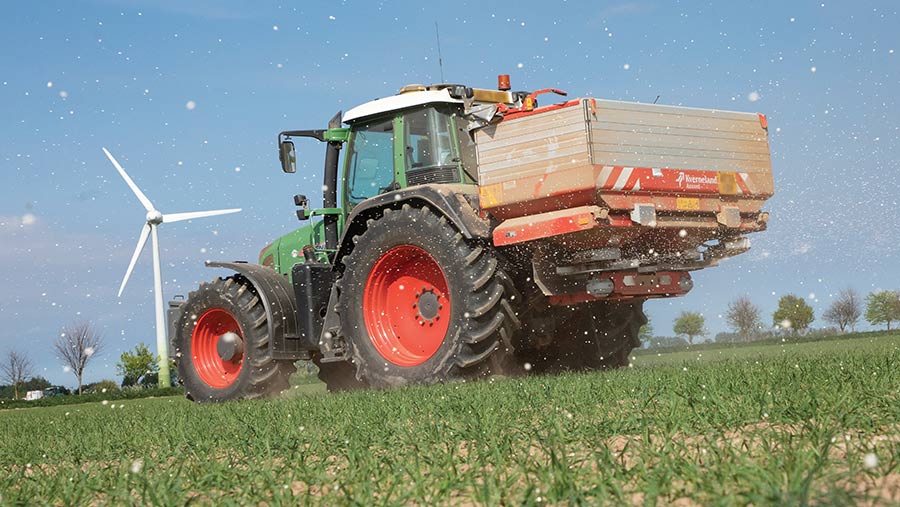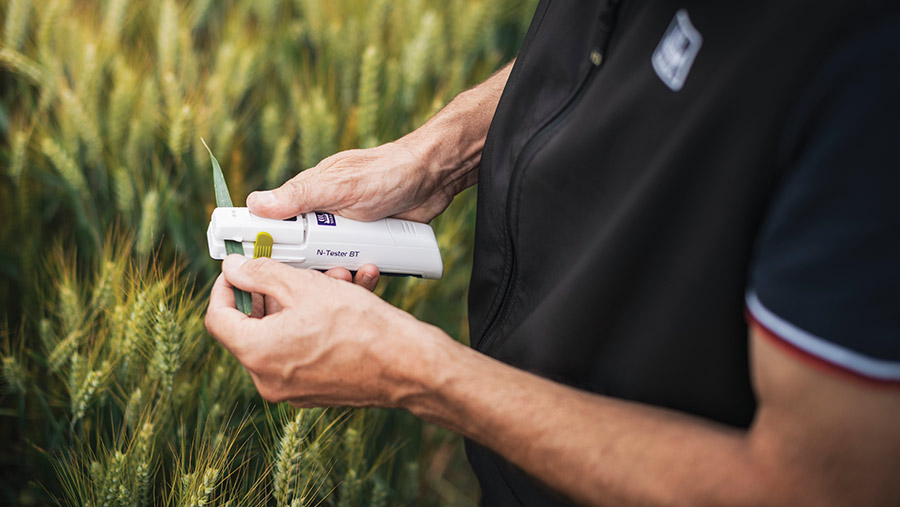Can data from improving NUE unlock financial gains?
 © GNP
© GNP Integrating various technologies, including remote sensing, soil measurement and canopy sensors to provide real-time seasonal information, is the key to a new project aiming to improve nitrogen use efficiency on farm.
Funded through Defra’s Farming Innovation Programme, the £2.8m NUE-Profits project is developing a “Framework for Improving Nitrogen Efficiency” (Fine).
The project is led by farm data analytics firm AgAnalyst and involves 10 other partners which are providing technology, farming and academic expertise.
Improving nitrogen use efficiency (NUE) – which will reduce the amount of nitrogen required to be applied – is perhaps the most crucial challenge arable farmers will face in meeting the net-zero target the UK is committed to reaching by 2050.
See also: Arable Insights farmers share spring nitrogen plans
Previous AHDB-funded analysis, which has been backed by other studies and individual farm carbon footprint assessments, suggests up to 80% of greenhouse gases emissions, in the form of nitrous oxides, on a typical arable farm can be assigned to the manufacture and use of nitrogen fertiliser on farm.
While fertiliser manufacturers are beginning to use new technology to produce green ammonia to reduce emissions in manufacturing, about 50% of emissions are from on-farm use.
And this is within the farmer’s gift to change, explains Clive Blacker, agronomy and precision technologist for AgAnalyst.
“Given nitrous oxide is 300 times more potent as a greenhouse gas than carbon dioxide, it is something we need to change.”
Typical farms are only 50-60% use efficient with nitrogen fertiliser, he notes.
“If we can improve that use efficiency, we can reduce nitrogen, which will reduce emissions.
“Research suggests we can achieve use efficiency of at least 70-80%, but it is difficult for farmers to know how to do that.
“It’s easy to be overwhelmed with different data streams and information sets, which are not linked or joined up and don’t give any sort of nitrogen forecasting insight based on seasonal variation and conditions.”
With environmental factors influencing efficient uptake of nitrogen, working out the best time to apply nitrogen and how much, as well as demonstrating improvement in use efficiency over time, is a challenge, he admits.
“But that’s where AgAnalyst and this project come in, with our ambition to make every farmer become their own data analyst.
“We’re keen to support farmers to use data they capture so they can make informed decisions.”
Nitrogen definitions
- Nitrogen fertiliser use efficiency (NfUE): Total amount of nitrogen supplied to the crop (manures and fertilisers) against the straw, grain and protein levels removed
- Nitrogen use efficiency (NUE): Total amount of nitrogen supplied to the crop from all sources (soil, manure and fertilisers) against that removed from all sources
- Margin over nitrogen/ha: (Yield (t/ha) x grain price*/t) – (nitrogen cost**/ha)
*Grain price £210/t **£360/t for ammonium nitrate
On-farm
On the home farm in Yorkshire, Clive has trialled using available technology, such as Yara’s N-Tester, to improve understanding of his crops in-season over the past few seasons.
The result was an increase in N fertiliser use efficiency from about 10% to about 70%.
“We then looked at using better recommendations, timings and reduced rates, such as a little-and-often approach, and in some cases improved it further above farm practice to over 90% efficiency.”
The trials show that theoretical higher nitrogen fertiliser use efficiency is possible, but that doesn’t take into consideration how much nitrogen is being supplied from the soil.
This is where calculations for true NUE become much more complex.
“Soil nitrogen tests can be quite variable and difficult to interpret,” says Clive.
“But the approach we’re taking in this project is to try to understand what’s in the soil, understand crop canopy growth and demand as it grows.”
The plan is to bring together data from various new and existing technologies in one platform by AgAnalyst, which will provide information and knowledge to improve NUE through simple-to-use tools, he explains.

Using an N-Tester resulted in a 10% increase in N fertiliser use efficiency on Clive Blacker’s farm © Yaris
Data cube approach
The project uses what Clive calls a data cube approach. This is where lots of measurements are made in one very small part of a field – typically either 24m or 36m square depending on tramline size – which minimises the influence from spatial variability.
Those measurements can then be used to extrapolate to the rest of the field, and through the remote sensing and modelling data provided from Assimila (see box) compared with previous seasons or other similar crops.
“The remote sensing and modelling will give us a daily update of the level of nitrogen uptake in the size of the crops, and also give a yield prediction with the aim to help budget our nitrogen and fertiliser strategies within the growing season,” Clive says.
He also hopes prototype soil moisture, temperature and nitrate sensors provided by Dales Land Net Soil Monitors will help provide more insight into how quickly applied nitrogen is taken up by plants.
This can vary considerably depending on the environmental conditions.
For every field, the data is used to produce an individual nitrogen response for that season, Clive explains. “And we use that for the nitrogen uptake measurements, calculations and recommendations.”
A dashboard is created for in-season daily monitoring of the crop – based on the crop modelling, fertiliser applications, weather and an estimation of soil nitrogen levels – using canopy growth and expected N uptake.
The data will visualise crop demand versus soil supply with the aim of creating thresholds to help farmers understand when a deficiency is yield-limiting, he says.
Nearly 50 farmer trials were carried out in the first year of the project, comparing standard practice with interventions based on analysis of the data collected.
With an April project start date, precise interventions around application timing and rates were difficult to set, but initial analysis shows some promise, as well as areas where more research is needed.
Project technology to measure and improve NUE
- Assimila’s Acropolis platform harnesses satellite and weather data with crop models to provide information, such as benchmarking, crop yield forecasts to about +/-10% accuracy 60 days from harvest, canopy cover data and crop development stages
- Dales Land Net Soil Monitors’ prototype soil probes provide soil moisture data to 50cm, soil temperature, and soil nitrate readings every 30 minutes
- University of Lincoln is creating 3D models of plants using mobile phone cameras for accurate calibration of leaf area index and biomass
- Soil sampling in spring and post-harvest
- Using a N-tester throughout the growing season
- Plant analysis for grain protein and straw nutrient uptake
Improvements
For example, across the 28 farms where final data has been collected and analysed, the data-led approach improved NUE, including the contribution from soil nitrogen, of 9%, says Jim Williams, executive chairman of AgAnalyst.
However, that increase in NUE only led to an improved margin over N cost in 25% of the trials. In the trials where margin was increased, the average improvement was £94/ha.
“But it’s not as straightforward as simply reducing your nitrogen rates,” Jim stresses.
“Which is the whole point of the project – to use data to understand when and where it is possible without impacting the bottom line.”
As more data becomes available with additional technology introduced, such as the soil probes, Jim expects the data-led approach to both improve NUE and build financial returns from using N more efficiently, as more timely interventions are developed.

